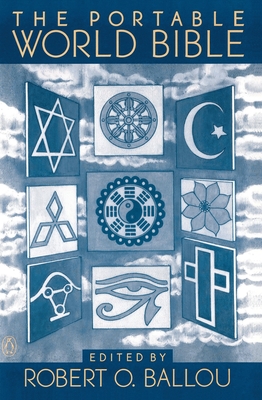
Many years ago, I was blessed to take an Introduction To World History course at Alice Lloyd College in Pippa Passes, Kentucky, under a man named Dr. Billy Rojas, Ph. D., who had come to ALC from the Chicago area as I recall. Billy, as he preferred to known by everyone he knew, required that students in all his history courses buy, and actually read sections of this book. Billy taught history from a viewpoint which was strongly focused on how religion and, particularly how differences in religion had influenced the flow of history over time. This book is edited by Robert O. Ballou, according to his publisher, Penguin Random House, brought to countless contemporary readers much of the world’s religious thought, which he selected, interpreted, and arranged in view of modern man’s quest for ultimate truths and values. His book, "The Portable World Bible" which has been in constant publication since its original publication in 1944, and is constantly relied on by students in many disciplines along with thousands of ministers, rabbis, imams, and priests. The book is broken into seven sections with each being composed of many of the key scriptures from most of the world's leading religions. It is an excellent resource for anyone who is interested in world religious beliefs, conflicts between believers in two or more of those beliefs, or simply anyone who wants to learn more about any particular major religion.
The sections are labeled The Hindu, The Buddhist, The Parsi, The Jew And The Christian, The Moslem, The Confucianist, and The Taoist.The book actually begins with a General Introduction and each of the sections begins with a specific introduction of about 10 to 15 pages. While a detractor could make the arguments that the book is a bit aged for today's world, or that it omits a few religions which have significant numbers of adherents worldwide, it is still a wonderful book for anyone who wants to actually understand how the religions of the world interact, conflict, and, oftentimes, agree. I have depended on it for some fast answers ever since the first time I ever read it in Billy Rojas' history class. I also have a friend of twenty years who is a minister in a rather conservative form of Christianity and a graduate of a seminary who also depends on it. For me, it is just as productive as any other book I can find when I need fast answers about key texts in any of the religions it discusses. Rarely will anyone write or edit a book which will still be in print more than 75 years after its initial publication. And I believe that this book will still be in use and publication in another 75 years. It is especially useful when we consider the perpetual, and currently volatile conflicts in the Middle East which are rooted almost entirely in religious differences based on three major religions whose most sacred sites are in a markedly small geographic territory in which their claimed sites often overlap. If you don't know about this book, at least look at a copy in a book store or library and decide if it is useful to you.
No comments:
Post a Comment